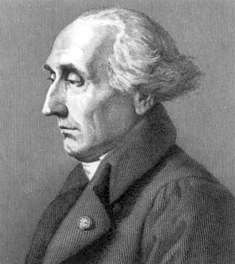- About MAA
- Membership
- MAA Publications
- Periodicals
- Blogs
- MAA Book Series
- MAA Press (an imprint of the AMS)
- MAA Notes
- MAA Reviews
- Mathematical Communication
- Information for Libraries
- Author Resources
- Advertise with MAA
- Meetings
- Competitions
- Programs
- Communities
- MAA Sections
- SIGMAA
- MAA Connect
- Students
- MAA Awards
- Awards Booklets
- Writing Awards
- Teaching Awards
- Service Awards
- Research Awards
- Lecture Awards
- Putnam Competition Individual and Team Winners
- D. E. Shaw Group AMC 8 Awards & Certificates
- Maryam Mirzakhani AMC 10 A Awards & Certificates
- Two Sigma AMC 10 B Awards & Certificates
- Jane Street AMC 12 A Awards & Certificates
- Akamai AMC 12 B Awards & Certificates
- High School Teachers
- News
You are here
Servois' 1817 "Memoir on Quadratures" – François-Joseph Servois
François-Joseph Servois (1767–1847) was born on July 19, 1767, in the village of Mont-de-Laval, located in the French Department of Doubs, near the Swiss border. Servois pursued several careers during his life: he was a priest, artillery officer, professor of mathematics, and Curator of the Artillery Museum, located in the 7th Arrondissement of Paris. He died on April 17, 1847, in Mont-de-Laval, where "his legacy remains legendary" [Boyer 1895a, p. 313]. Readers interested in a more in-depth biography of Servois can refer to Bradley [2002], Petrilli [2010], and Petrilli [2017].
In a list of all mathematicians, Servois would rank as lesser-known. To the extent that his name is known at all, it is for introducing the words "distributive", "commutative", and "pole" into mathematics. However, Servois made significant contributions, in particular to the field of the Calculus of Derivations (or Operator Calculus). We feel his three major works were:
-
Solutions peu connues de différents problèmes de géométrie-pratique1
-
"Essai sur un nouveau mode d’exposition des principes du calcul différentiel"2
-
"Réflexions sur les divers systèmes d’exposition des principes du calcul différentiel, et, en particulier, sur la doctrine des infiniment petits"3
The first is Servois’ only book, which was published in 1804. This geometry text, which Servois compiled during his career in the military, was intended to be a reference on applied geometry for military officers, presenting constructions in ruler-geometry that could be used on the battlefield at any time [Bradley 2002]. This book brought him fame among specialists—indeed, the great mathematician Jean-Victor Poncelet (1788–1867) consulted Servois for his expertise on geometry several times during the writing of the 1822 edition of the Traité des propriétés projectives [Taton 1972].
Readers interested in Servois’ geometry textbook can refer to the English translation located in [Servois 1804]. As this stands as Servois’ first major work in mathematics, it exposes us to the type of mathematician that Servois would become. It is clear that military personnel would not be interested in the geometric justifications for these constructions, but rather would prefer the simplest possible steps for completing these tasks quickly. Nevertheless, Servois provided proofs of all of his applied constructions throughout the book. Later in his mathematical career, we see that Servois became a strong advocate of rigor4 in mathematics.
 |
In 1814, Servois, following in the footsteps of Joseph-Louis Lagrange (1736–1813), proposed a foundation for calculus based on power series through the publication of his "Essay" [Servois 1814a]. Servois developed therein the known rules of the differential calculus using his definition of the differential:
\[dz = \Delta z - \frac{1}{2} \Delta^2 z + \frac{1}{3} \Delta^3 z - \ldots,\]
and the linear operator properties of the differential. He wrote a follow-up paper, the "Reflections" [Servois 1814b], as a philosophical justification of his work in the "Essa"' and an explanation of how basing the calculus on power series brought rigor to the subject. Readers interested in Servois' contributions to the foundations of calculus can refer to [Bradley and Petrilli 2010a] and [Bradley and Petrilli 2010b].
After a three-year break, Servois returned to research in calculus, but this time with a focus on numerical integration [Servois 1817]. From a psychological point of view, this “Memoir on Quadratures” illustrates Servois' return to the frame of mind that he was in when he wrote his geometry textbook. In this paper, Servois was not concerned with rigor and foundations, but rather with the practical applications of numerical integration. All the same, he provided derivations and proofs appropriate to this stage of the development of calculus. He also engaged in debates over the utility of divergent series, a topic that was of relevance to the subject.
In the next section, we summarize the dispute that motivated Servois to write his “Quadratures'” paper.
Notes:
1. Little-known Solutions to Various Problems in Practical Geometry. Petrilli [2017] includes an English translation of this monograph.
2. "Essay on a New Method of Exposition of the Principles of Differential Calculus." Bradley and Petrilli [2010a] includes an English translation of this paper.
3. "Reflections on the Various Systems of Exposition of the Principles of the Differential Calculus and, in particular, on the Doctrine of the Infinitely Small." Bradley and Petrilli [2010b] includes an English translation of this paper.
4. In mathematics, the term rigor has many definitions. The most appropriate definition for describing Servois’ notion of rigor is provided by Grabiner [1981, p. 5]: First, every concept of the subject had to be explicitly defined in terms of concepts whose nature was held to be already known. ... Second, theorems had to be proved, with every step in the proof justified by a previously proved theorem, by a definition, or by an explicitly stated axiom. Third, the definitions chosen, and the theorems proved, had to be sufficiently broad to support the entire structure of valid results belonging to the subject.
Robert E. Bradley (Adelphi University) and Salvatore J. Petrilli, Jr. (Adelphi University), "Servois' 1817 "Memoir on Quadratures" – François-Joseph Servois," Convergence (May 2019)




